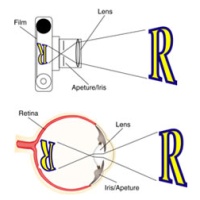The Science of Vision: An Introduction
David Leech Anderson: Author
Rob Stufflebeam: Animations
 |
MODULE DESCRIPTION The human vision system takes information from the world in the form of light that strikes the eye's retina after reflecting off of objects. Somehow the system takes the two-dimensional information from the retina and recreates a three-dimensional world in experience. Explaining exactly how this feat is accomplished is known as the inverse problem. Evidence can be drawn from visual illusions and other unusual visual phenomena that give clues regarding how the brain processes information as we see what happens when some part of the system breaks down. This module offers animations that bring students face-to-face with some of the puzzles of their own vision system and motivates them to consider a variety of research methods that might be used to unravel those puzzles. |
MODULE COMPONENTS:
Explore the ways our visual system responds to the famous Müeller-Lyer illusion and competing theories for why that is.
Introduction to the Science of Vision
Methods Used in the Study of Vision
ADDITIONAL RESOURCES
Introduction to the Methods Used to Study Perception
Introduction to the Scientific Method
Funding:
This module was supported by National Science Foundation Grants #9981217 and #0127561.


